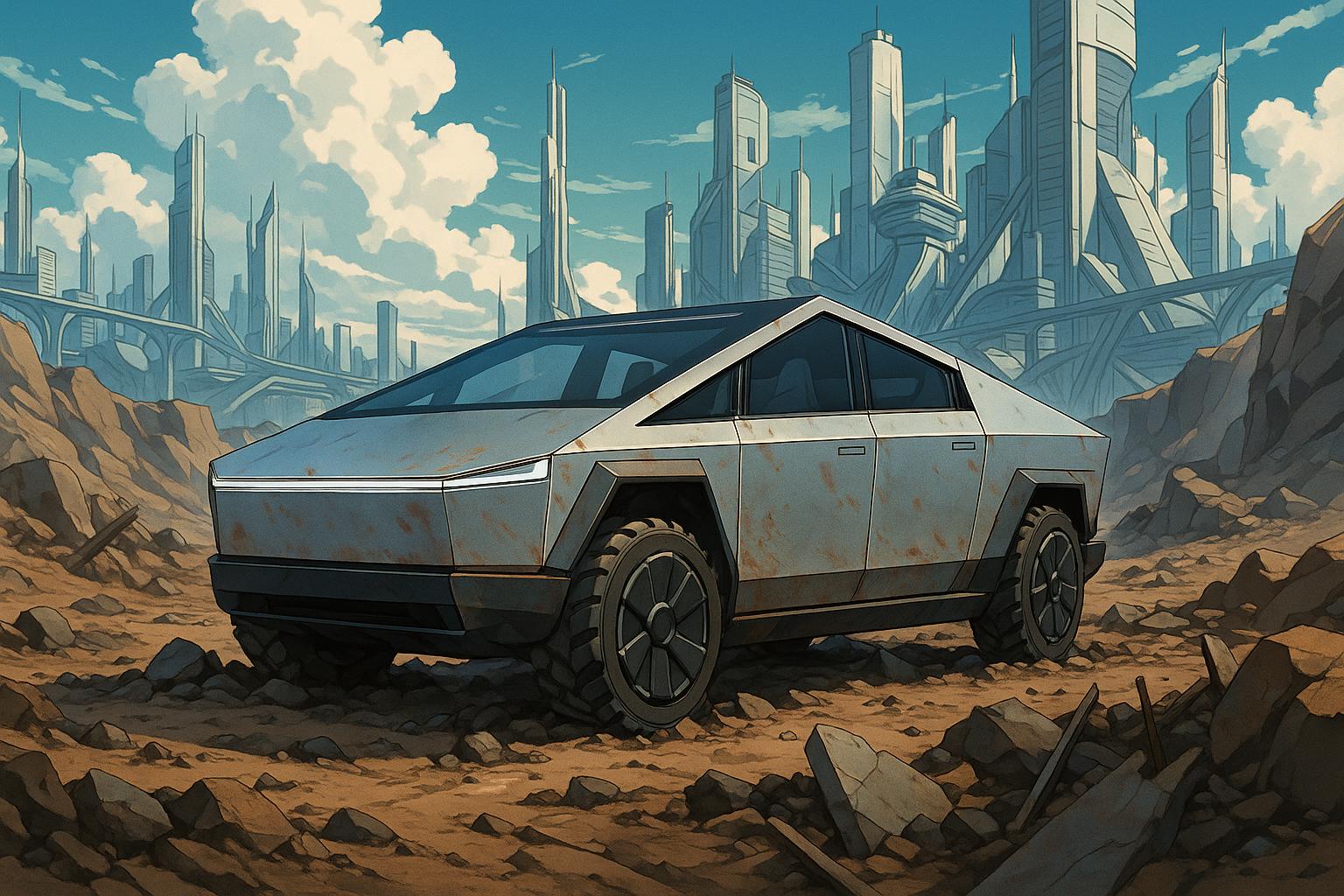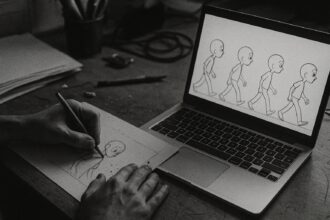Initially hailed as an unstoppable electric truck, Tesla’s Cybertruck now faces scrutiny over recalls, rust, and pedestrian safety risks, challenging its futuristic image amid divided public opinion and shifting market expectations.
The Cybertruck was heralded as a revolutionary vehicle, designed to be indestructible and appealing even to the most dubious of characters, such as an imagined Chechen warlord. Described as a “Doomsday chariot,” this angular, stainless steel contraption was intended to dominate the roads, boasting features purportedly making it immune to both bioweapon attacks and the ravages of road rage. However, initial enthusiasm has given way to a mounting realisation that the vehicle might struggle even with mundane tasks, such as navigating to the grocery store.
Recent reports have illuminated a series of challenges surrounding the Cybertruck, raising significant concerns about its functionality and safety. Issues with the accelerator pedal, which led to recalls, and incidences of the vehicle becoming immobilised in various terrains have surfaced, highlighting a stark contrast to its grand marketing narrative. Furthermore, experts have scrutinised its unusual stainless steel exterior, noting early signs of rust and questioning the structural integrity of its sharp-edged design. Safety analysts warn that the Cybertruck’s considerable weight and speed, combined with its audacious aesthetics, create potential risks for pedestrians and cyclists alike.
The reaction from the public has been equally mixed. Some praise its bold appearance and innovative attributes, while others voice scepticism regarding its practical application. Critics of the design argue that the aggressive angles and hefty bulk challenge notions of what a truck should be, questioning whether Tesla has misjudged its market. In a recent video, opinions reflected this division, with viewers torn between admiration for the car’s futuristic style and doubts over its everyday usability.
Meanwhile, the Cybertruck’s industry context continues to evolve. As Tesla faces backlash from critics of Elon Musk’s controversial public persona, the vehicle’s anticipated role in reshaping the electric automotive landscape is experiencing growing scrutiny. While it promised to revolutionise the truck market, analysts are left pondering whether it can effectively meet consumer expectations or become a costly misstep in Tesla’s ambitious journey.
In juxtaposition, the realm of storytelling unfolds through different narratives, drawing parallels in their complexities. Nobel laureate Kazuo Ishiguro recently discussed the nuances of adaptation at the Cannes Film Festival, reflecting on the enduring nature of his debut novel, A Pale View of Hills. He welcomed creative liberties in adaptations, suggesting they breathe contemporary life into classic tales. Ishiguro’s thoughts resonate in our current society, which often grapples with the balance between innovation and adherence to tradition. As varied as the Cybertruck and Ishiguro’s stories are, they both illustrate our pursuit of capturing and reshaping experiences, whether on the road or through art.
In these polarising times, meaningful communication remains critical. As technology progresses, opportunities for authentic connections can dwindle, leading to crucial conversations going unheld. Experts have emphasised the importance of engaging dialogue about our shared human experience, suggesting that these discussions can bridge divides exacerbated by modern digital exchanges. The enhancement of understanding through conversation could be seen as an antidote to the isolation fostered by extravagant advancements, much like those promised by the Cybertruck.
The juxtaposition of the Cybertruck’s ostentatious image with the underlying narrative of human connection challenges us to rethink both our automotive expectations and the way we engage with one another in an increasingly complex world. As we navigate through technological marvels and literary reflections, it becomes clear that meaningful connection—whether through conversation or the vehicles we choose to drive—remains paramount in shaping our collective future.
Reference Map
- Paragraph 1: [1], [2], [4]
- Paragraph 2: [2], [4]
- Paragraph 3: [5]
- Paragraph 4: [2], [3]
- Paragraph 5: [6]
- Paragraph 6: [3]
- Paragraph 7: [6]
Source: Noah Wire Services
- https://www.theguardian.com/news/2025/may/17/six-great-reads-cybertruck-conversations-we-need-to-have-gentleman-crook – Please view link – unable to able to access data
- https://www.theguardian.com/technology/2024/apr/20/cybertruck-failures-tesla-elon-musk – This article discusses the numerous issues faced by Tesla’s Cybertruck, including malfunctions with the accelerator pedal leading to a recall, reports of the vehicle getting stuck in various terrains, and concerns over its stainless steel exterior rusting. The piece highlights the challenges Tesla has encountered with the Cybertruck’s design and functionality, contrasting its initial marketing as a ‘Doomsday chariot’ with the reality of its performance and safety concerns.
- https://apnews.com/article/c8fd777b6a530bd0692adee8dcaf39aa – At the 2025 Cannes Film Festival, Nobel laureate Kazuo Ishiguro discussed the premiere of a film adaptation of his debut novel, ‘A Pale View of Hills,’ directed by Kei Ishikawa. Ishiguro emphasized his support for creative reinterpretations of his works, encouraging filmmakers to infuse adaptations with their own contemporary relevance rather than adhering too reverently to the source material. He likened film adaptations to fireside storytelling moments that give stories longevity.
- https://edition.cnn.com/2024/08/29/business/cybertruck-tesla-nightcap/index.html – This article examines the Tesla Cybertruck’s design and safety concerns, highlighting its sharp-angled, 7,000-pound stainless steel frame and rapid acceleration. Safety experts have raised questions about the vehicle’s sharp edges and massive blind spots, which could pose risks to pedestrians and cyclists. The piece also discusses the Cybertruck’s weight and speed, noting that it is much heavier and faster than the average car on the road, presenting potential hazards in the event of a collision.
- https://us.cnn.com/videos/business/2024/02/20/tesla-cybertruck-review-price-elon-musk-contd-gr-orig.cnn – This video features reviews of the Tesla Cybertruck from both fans and critics. Reactions range from admiration of its design to criticism of its practicality and performance. The video provides a comprehensive overview of public opinion on the Cybertruck, highlighting the divided perspectives on its aesthetics, functionality, and place in the automotive market.
- https://www.theguardian.com/news/2025/may/17/six-great-reads-cybertruck-conversations-we-need-to-have-gentleman-crook – This article presents six notable reads, including a deep dive into the Cybertruck’s design and performance issues, an interview with Kazuo Ishiguro about his novel ‘A Pale View of Hills,’ and discussions on meaningful conversations in polarizing times. It also features an exploration of the challenges faced by pubs and restaurants, and a personal account from Edgar Feuchtwanger about living next to Adolf Hitler during the 1920s.
Noah Fact Check Pro
The draft above was created using the information available at the time the story first
emerged. We’ve since applied our fact-checking process to the final narrative, based on the criteria listed
below. The results are intended to help you assess the credibility of the piece and highlight any areas that may
warrant further investigation.
Freshness check
Score:
8
Notes:
The narrative is recent, referencing May 2025 and discussing ongoing issues with the Cybertruck. However, some information and themes are consistent with previous discussions, suggesting a mix of new and recycled content.
Quotes check
Score:
6
Notes:
There are no direct quotes in the narrative to verify. The inclusion of Kazuo Ishiguro’s thoughts is general and lacks specific sources or dates, making it difficult to determine the original source.
Source reliability
Score:
9
Notes:
The narrative originates from The Guardian, which is generally considered a reputable and reliable publication. The references to other reputable sources like CNN and AP News add to its credibility.
Plausability check
Score:
8
Notes:
The claims about the Cybertruck’s functionality and societal impact are plausible given the vehicle’s controversial reception and ongoing industry developments. However, some assertions about its safety and design might be speculative without concrete evidence.
Overall assessment
Verdict (FAIL, OPEN, PASS): PASS
Confidence (LOW, MEDIUM, HIGH): HIGH
Summary:
The narrative is well-supported by recent events and reliable sources, though it combines old and new information. The lack of specific quotes affects the quotes score, but overall, the content is plausible and well-represented.













